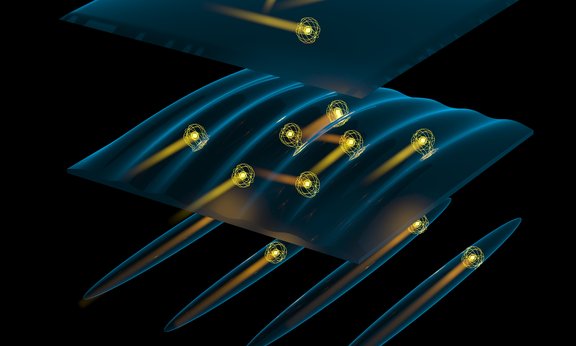Inhabitants of the inner cities of Manhattan or Miami have known it all along: On short distances, up to the length of a block, the world inside the “urban canyons” of the city appears to be one-dimensional. Only one direction is preferred. However, with the cross streets present on longer distances, the world is two-dimensional: It is possible that one explores the transverse direction when traveling far enough. Quantum particles, confined at ultralow temperatures to “optical canyons” with the possibility to quantum tunnel to neighbouring canyons, also “know” what their dimensionality is: They are 1D on short distances, but 2D on long distances. Such behaviour has recently been revealed in a joint experiment-theory work by researchers from the Department of Experimental Physics at the University of Innsbruck and in the Department of Quantum Matter Physics at the University of Geneva.
Quantum systems in reduced dimensionality and at ultralow temperatures in the regime of superfluidity and quantum degeneracy have become a rich field of research. Two-dimensional superfluids may contain topological excitations, and interacting one-dimensional systems feature a multitude of unusual properties, of which fermionization of bosons is one of the most striking ones. Little is known about the regime of the dimensional crossover: How do strongly interacting 2D bosonic superfluids connect to fermionized bosons in 1D? Using cold atoms as a research platform, the dimensional crossover can now be studied directly in the experiment. In a first test, the physicists probed the correlation properties of interacting bosons confined to variable crystals of light. In mixed dimensionality, they found a characteristic two-slope decay for the one-body correlation function, mirroring the fact that the particles are 1D and 2D at the same time. “Our system is 1D and 2D simultaneously”, says one of the lead authors of this work, Yanliang Guo, who is a postdoc in Innsbruck. “It depends on how we interrogate the system”. Hepeng Yao, a postdoc in Geneva who has carried out the numerical simulation and analysis by state-of-the-art quantum Monte Carlo methods, agrees: “We can now directly track how the continuous change of a system’s dimensionality affects the collective properties of a superfluid.”
“Our experiments had a surprise for us in store”, says Yanliang Guo. “In view of our high-quality numerical modelling, we can now use the correlation measurements to determine the temperature of our quantum liquids in 1D, 2D, and in between, with very high precision. This might open the avenue to new discoveries, for example for the exploration of the elusive Bose-glass phase.” Hepeng Yao concurs: “The correlation measurements, when done for bosons at very low temperatures in the presence of a random potential, should show signatures of the Bose glass.”
The results, recently published in the journal Nature Physics, will serve as a starting point for further research on low-dimensional quantum matter and its dimensional crossover. The research has been funded by the Austrian Science Fund FWF within a Wittgenstein prize grant, by the European Union via an ERC grant, and by the Swiss National Science Foundation. Milena Horvath is a member of the FWF doctoral program Atoms, Light and Molecules (DK-ALM).
Publication: Observation of the 2D–1D crossover in strongly interacting ultracold bosons. Yanliang Guo, Hepeng Yao, Satwik Ramanjanappa, Sudipta Dhar, Milena Horvath, Lorenzo Pizzino, Thierry Giamarchi, Manuele Landini, Hanns-Christoph Nägerl. Nature Physics (2024) DOI: 10.1038/s41567-024-02459-3

